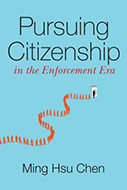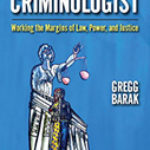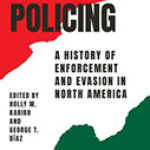Pursuing Citizenship In The Enforcement Era

Author: Ming Hsu Chen
Publisher: Stanford, CA: Stanford University Press, 2020. 232p.
Reviewer: Shannon Gleeson | May 2021
As an immigration scholar, one of my frequent complaints is the lay misconception around the meaning of citizen. The term is oftentimes used to normatively signify an upstanding community member. Or a person “who isn’t a citizen” is frequently presumed to lack any legal status at all.
This quotidian discourse reflects the tenor of some scholarship on immigration and citizenship. In the United States especially, social scientists have long focused on the stark dichotomies of legal status, and the chasm between the documented and undocumented, authorized and unauthorized, citizen and non-citizen. This is understandable given the disproportionate political and budgetary focus on immigration enforcement, to devastating effect for the nearly 11 million individuals who live without legal status in the United States, as well as the many more non-citizen immigrants subject to deportation.
Meanwhile, our inquiries into the process of naturalization (the legal procedure to formally become a U.S. citizen) often presume citizenship to be the apex of the U.S. immigration labyrinth, to which surely everyone endeavors and is eligible. Then, once becoming a full citizen, the rewards should flow, such as the right to vote, the ability to gain federal employment, and access to the prized U.S. passport. In her new book Pursuing Citizenship in the Enforcement Era, however, law scholar Ming Hsu Chen offers several vital correctives to these popular and scholarly tropes.
The book starts by excavating the institutional landscape that immigrants encounter in the United States. In doing so, it makes two important distinctions. First, Chen differentiates between formal and substantive citizenship. Whereas the former refers to the many different legal categories into which immigrants are sorted, substantive citizenship comprises the feelings of belonging and membership that individuals experience in society. For immigrants, these overlay the various axes of integration that empirical immigration scholars spend their careers measuring and mapping.
Second, within each of the categories of formal and substantive citizenship, Chen highlights the heterogeneity of the immigrant population and the immigrant experience. These legal categories have historically been racialized by national origin, and racism is the root of many of the inequities engrained in the U.S. immigration system today. To this end, immigrants can diverge in their experiences of substantive belonging, depending on the realm of their everyday life (social, legal, economic, political).
Taken together, Chen argues, full citizenship relies on achieving both formal and substantive citizenship. Rather than simply a series of legal categories, citizenship is a spectrum onto which immigrants are sorted, depending on their own characteristics (especially their race and class position) and institutional context.
A Bottom-up Inquiry across the Citizenship Spectrum
Chen is not alone in complicating our understanding of the U.S. immigration bureaucracy. She is, however, one of a small cadre of political theorists who do so by actually asking immigrants directly about why they pursue citizenship, and about their experiences in doing so. Her interview methodology is impressive in its scope; the author interviews many different categories of immigrants – including undocumented immigrants, those with Deferred Action for Childhood Arrivals, temporary visa holders, refugees, and legal permanent residents. And unlike many retrospective studies that ask immigrants to recount why they became a citizen, Chen leverages her unique access to community-based spaces to talk to immigrants in situ just as they commence the long process of applying. This way of understanding citizenship illuminates the central question of who feels American, and why (or why not).
The author starts her analysis by providing the unacquainted with a guided tour of the various possibilities that immigrants confront upon arrival into the United States. Along the “lawful” path, one can either go directly to lawful permanent residence (also known as green card holders, via family or employer-based sponsorship), or into a temporary visa status, which in many instances allows for eventually transitioning into legal permanent residence (LPR). After a time within LPR, one can eventually apply to naturalize.
On the other track, the vast majority of poor and non-white immigrants across the world must resort to unlawful entry, which only very rarely provides a pathway to citizenship. And once their time has run out, even temporary visa holders can also fall into undocumented status and become subject to deportation, a fate from which LPRs are also not safe. In sum, the path to citizenship in the United States is uneven and windy, and has changed dramatically over time.
The current U.S. immigration system offers tiered pathways to citizenship, some more treacherous and risky than others. Even documented immigrants, Chen reminds us, are not a monolith. They vary across national origin, institutional location, and arguably even gender and age (two variables Chen does not significantly address in her analysis). The four most prominent paths of entry – employer-based, family sponsorship, refugee, and military – all have a different burden of proof and normative valuation in U.S. society. These immigrants’ relationship to the project of U.S. citizenship in turn also varies. Chen joins the growing ranks of social scientists and legal scholars shining a light on the legal uncertainty of temporary immigrants, including those precariously situated migrants with the Deferred Action for Childhood Arrival (DACA) status who especially reflect the ambivalence of U.S. immigration policy.
The Enforcement Epidemic and Prospects for Facilitating Integration
In 2002, in the aftermath of the 9/11 attacks, the U.S. immigration system underwent a series of profound changes. Perhaps most significantly, the nearly seven decades old Immigration and Naturalization Service was reconstituted into the Department of Homeland Security. In addition to a redoubling surveillance and enforcement efforts, the new DHS responded to a long call by critics on both sides to decouple the immigration enforcement and service functions of the agency. The “good cops” and “bad cops” of federal immigration activity were now presumably delinked. Yet, what Chen’s Pursuing Citizenship lays bare, is the ways in which the enforcement bias at the DHS and throughout the federal government ultimately overwhelmed every aspect of immigration in the United States, including for authorized immigrants eligible to pursue naturalization. As she argues, “citizenship theory can improve integration,” by which we can fully appreciate how citizenship consists of “braided strands of rights, benefits, and identities” (118). In other words, naturalization is ultimately not a guarantee of belonging, as the experience of “semi-citizens” such as racial minorities and women might attest.
Chen’s account is a quintessentially American tale, focusing on the everyday experiences of immigrants who end up in places like Colorado where her interviews are set. Yet, this volume begs the question of the exceptionality of the U.S. immigrant experience. The stark lines that the U.S. draws around its – admittedly still porous – borders differ from contexts like the European Union, where national citizenship regimes abut regional frameworks. What might the category of semi-citizen mean in another immigration context, where a dense landscape of national governments coordinate not only with local jurisdictions, but also where supranational state and market entities structure the meaning of territorial, political, and economic belonging?
Normative Prescriptions
Inevitably, this ambitious volume leaves some important terrain uncovered, and perhaps insufficiently interrogates the implications of some of the pathways to citizenship it describes. While critical race theory figures prominently in its introduction, the role of race in shaping the experiences of immigrant integration is largely secondary. Similarly, the author does not provide a robust feminist critique of immigration policy in the United States, as have other scholars such as Laura Briggs and Evelyn Nakano Glenn. This is not the book to document the U.S.’s long racist history of (neo-)colonialism and military pillaging that has created many of the diasporas to the United States, and which arguably justifies mass immigration reform as a form of reparations. Yet, Pursuing Citizenship is the only volume I can think of to handle the entirety of the different aspects of the immigration regime in relation to each other. This holistic approach is important, because in considering the full set of tiered pathways to citizenship, we might better understand the racialized and weaponized specter of illegality in the United States. And by engaging these diverse immigrant experiences, we can fully appreciate the devastation that the enforcement regime has wrought on many more than just the undocumented immigrants who have been systematically left out of the path to citizenship altogether.
Ming Hsu Chen writes with a brave mix of pragmatism and justice-mindedness. Most social science tends to either avoid policy prescriptions (which we leave to the beguiled reformers on the ground), or indignantly declares the need for sweeping revolution to achieve real equality. These visionary approaches are necessary to imagining just futures. Chen, in contrast, embraces the need for practical steps forward, knowing the critiques she leaves herself open to on all sides. In doing so, she jumps into the fray to force a long overdue conversation. The terms of this national debate have already been set overwhelmingly, by the likes of the Heritage Foundation and the Center for Immigration Studies, both of which have had enormous influence on U.S. immigration policy debates — despite the latter being defined as an extremist hate group by the Southern Poverty Law Center. Chen here demands that we migration scholars stake a deeper claim in the changes that are needed to ensure all of our well-being. Pursuing Citizenship is an essential read for all of us committed to accepting that challenge.
Shannon Gleeson, Associate Professor, Cornell University


